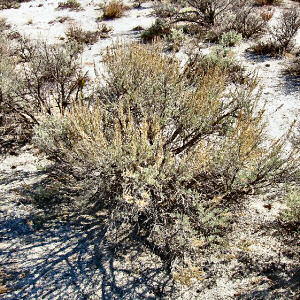
Sagebrush was everywhere in 1931, when the workers rode the transports from camp to the dam site.
With stems smooth and silvery with evergreen wedge-shaped leaves, the plant is part of the Artemis family named after the Greek virgin goddess of the hunt and wild nature. It is Nevada's state plant.
It can also grow the size of a grown man up to seven feet tall. It's stout at its trunk with silvery branches and dense clusters of tiny yellow or cream-colored flowers that bloom in late summer. It's seeds are tiny and black and each plant may produce up to one million seeds.
The sagebrush supports many wildlife species, such as pronghorn, mule deer, grouse and many small mammals. Sage grouse use large clearings in the sagebrush habitat to conduct spring mating dances. Early morning, one can see in these areas, known as leks, males inflating yellow air sacs upon their chest, puffing up their feathers and spreading their tail feathers before strutting around the lek in the attempt to bond with one or more females. The sagebrush then can be said to act as audience.
The leaves contain aromatic oils with a turpentine fragrance, and after a rainstorm, they perfume the air with a sweet, pungent aroma. For those that come upon sagebrush in the desert, it is delightful. There is so much of it everywhere, it can be said to give the feeling of prosperity. Especially to the men that came upon its abundance, after being so long out of work, and on the streets, standing in line for bread.
When it was actualized, when the men felt they had suddenly "hit it rich" by getting a job at the dam, three square meals a day and a bed to sleep in, suddenly men, like sagebrush, were everywhere.
Yet prosperity is not worth much unless it is useful beyond the day to day requirements for living. And it is known that sagebrush is not only an abundance of color amid the parched desert, it can be used for fuel or as Native Americans once did, used in building. The leaves and the seeds can be eaten. And the leaves, which contain camphor, can be used medicinally for coughs, colds, headaches, stomach aches, fevers and to relieve pain during child birth! Poultices of wet leaves can be applied to bruises to reduce swelling.
Beyond that, Navajo weavers would boil the leaves and flowers to create a yellow-gold color, used to dye wool. The Ute's used the shredded bark for candle wicks.
The men working on the dam made the dam prosperous, and each man had a use far and above his function as a worker. His thoughts created a tempo for the time. His communication with others offered insight to aid in understanding and perspective. In other words, what we see before us is outright amazing, no matter if it's the sight of something along the road. But it's the thing itself that harbors the real amazement. We must get closer still to what interests us. Study it in action.



